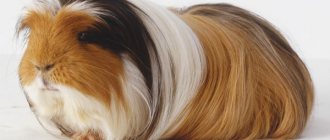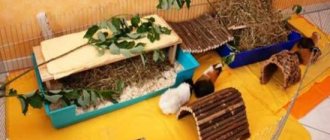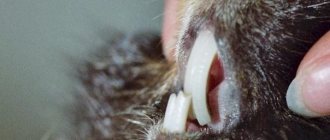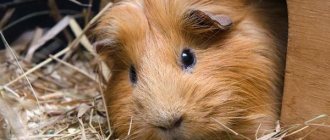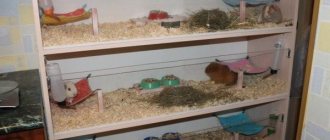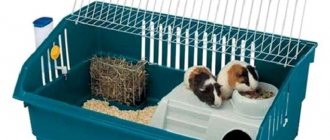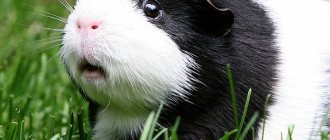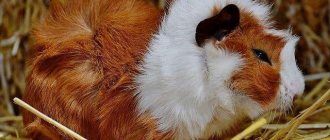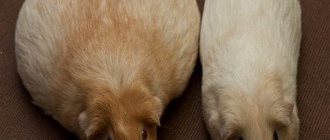To begin with, it is worth noting that a guinea pig sheds twice a year - in early autumn and late winter. This is a natural physiological process that should not be feared. At home, such molting can drag on for a much longer period, since the weather around the animal practically does not change. You need to worry if obvious causes of the problem are noticeable: the guinea pig sheds too much or goes bald, the fur becomes unkempt, the skin is red and flaky. In such cases, you need to sound the alarm and start treatment.
Causes of hair loss
If your guinea pig is experiencing unseasonable hair loss, it can be caused by a number of factors:
- Fungus;
- Skin parasites: fleas, lice eaters, ticks and others;
- Allergy;
- Stress;
- Lack of vitamins.
Quite often, guinea pigs shedding occurs due to a nutritional problem. There is a clear lack of vitamins C and B in the diet. In this case, hair loss is especially noticeable in winter, when there is no fresh food. By summer everything is back to normal and there are no more symptoms. Another cause of shedding may be lichen or another fungus. If your pet begins to come into contact with animals, the reason may be skin parasites. Most often we are talking about lice, fleas, lice-eaters and ticks. Severe stress and unexpected drastic changes can cause dullness and excessive hair loss. A guinea pig may have some kind of gray hair. The reasons for this phenomenon may be new roommates, loud noises, sudden changes in temperature, moving and other factors.
Why do guinea pigs shed?
Shedding is a natural process during which new fur grows in place of the lost fur. Coat change can be seasonal or juvenile (age-related). If the animal is kept in good conditions and eats properly, then molting usually takes place without any negative consequences.
But it happens that this process is not associated with natural causes. It can be caused by poor diet and lack of vitamins in food, improper living conditions, stress, pet illness or parasites.
Attention! If your pet's fur is actively falling out throughout the year, bald patches appear, the skin turns red and peels, pay attention to these symptoms. The animal needs treatment or changes in living conditions.
Shedding without pathology
Some breeds of pigs go bald in the first two months of life. This is a natural process, since they grow up completely bald. A striking example is Skinny the pig. All other guinea pigs shed in the fall and spring. This is a physiological process that does not need to be fought. The first molt occurs around September and occurs without any problems. The body is stronger and filled with vitamins thanks to good nutrition with fresh foods and herbs. Another thing is hair loss in February, when the basis of the diet is hay, which does not have so many nutrients. To make the process less painful, use a variety of feed additives.
If a young pig grows hair, the baby's outfit is replaced with a more mature one. The process is called juvenile molting, and it occurs once in the life of each pig.
Another cause of hair loss in a guinea pig can be injury. This also includes burns caused by high temperatures and chemicals. After regeneration, the hair will recover on its own.
When natural shedding occurs in guinea pigs, it is accompanied by weakening of the skin. During this period, behave very carefully with her. To mitigate the process, you can buy vitamin complexes or veterinary drugs, depending on the situation.
Pododermatitis
Pododermatitis is a fairly common phenomenon among rodents, characterized by a disease of the paws and otherwise called “painful heels.” Most often, the disease affects the guinea pig's hind limbs and hock joint.
Causes
The following factors contribute to the development of pododermatitis:
- Inappropriate conditions for keeping a piglet. Dampness and dirty litter are favorable soil for the proliferation of pathogenic bacteria.
- Excess weight of the pet, it puts additional stress on the paws.
- Low physical activity of the pig.
- Uneven, wire floor in the cage. If every step causes deformation of the animal's foot, it is likely to develop pododermatitis.
- Lack of certain vitamins, in particular vitamin C.
- Claws cut at the wrong time.
An animal affected by pododermatitis will bend its legs and become limited in its movements. Hair falls out on the affected limb, swelling and redness occur.
Then, without appropriate treatment, ulcers and wounds appear on the paw, the animal becomes lethargic and apathetic, and may even cry.
Treatment
It is very important to prevent the development of pododermatitis. That’s why clean the cage on time, use soft material for filler that will not injure your pet’s paws, and trim overgrown claws in a timely manner. If it does develop into pododermatitis, be prepared that it will take quite a long time to treat it. The wounds on the paws are first treated with solutions of chlorhexidine or hydrogen peroxide.
Then Levomekol or Solcoseryl ointment is applied. Antibiotic therapy is sometimes required if the wounds are severe and threaten to develop into blood poisoning. In severe cases, an x-ray may be necessary to ensure the bone is intact.
( 2 ratings, average 4.5 out of 5 )
Lack of vitamins
The easiest way to eliminate the lack of vitamins. It is quite simple to understand that this is the cause of baldness. The pet has no wounds or redness, eats well, and his behavior has not changed. In this case, it is enough to replenish the body’s need for missing vitamins C and B.
Add more fresh foods to your diet: greens, apples, carrots, sprouted grains, parsley and dill. During this period, it is recommended to feed bean hay. It would be a good idea to add a little ascorbic acid to the water, about 20–25 mg per day.
Fungal diseases
If your guinea pig's fur is falling out in clumps, the problem may be caused by a fungus. Mostly these are lichen or dermatophytes. Diseases are characterized by their foci. They begin to develop on the face, if treatment is not started in time, they move to the neck and paws. If you ignore these symptoms, they affect the entire skin of the animal. In this case, pronounced symptoms of fungal diseases arise: severe itching, redness, bald patches, and in advanced cases, purulent wounds. Further development of the disease will lead to death. Be careful, lichen is transmitted to humans.
To prevent this situation from happening, carry out regular cleaning and disinfection of the cage and all contents. Ventilate the room regularly and maintain air humidity. Treat your pet for internal and external parasites. Try to give only high-quality food. When purchasing a new pet, place it separately from other pets for a few days. Monitor for the presence of diseases and abnormalities. It is easier to treat one animal than all of them at once.
If the presence of the disease is confirmed, begin treatment immediately. Although chlorine-containing solutions are harmful to animals, they should be used to treat the skin first. This will help delay the development of the disease and give some time.
To combat fungal diseases, veterinarians often recommend Nizoral shampoo, which can be purchased at any pharmacy. It allows you to quickly reduce and, in a few procedures, cure itching, inflammation and redness. Apply the drug to the required areas, rinse with warm water after 5 minutes.
You can use Fungoterbin 1% and Thermikon 1%. Creams do an excellent job with dermatitis and various fungi. It should be applied to the affected areas 3 times a day. If there is not a single product in the pharmacy, you can buy Fukortsin or Castellani.
Home remedies for nasal congestion
Home remedies can help when you experience nasal congestion. However, do not self-medicate - consult a therapist.
Humidifiers, which add moisture to the air, can help break up mucus and soothe sore nasal passages. However, if you have asthma, ask your doctor before using a humidifier.
Propping your head with pillows can also stimulate the flow of mucus from your nasal passages.
Saline sprays are safe for all ages, but for children you will need to use an aspirator or nasal bulb. An aspirator is used to remove any remaining mucus from the baby's nose.
Diseases caused by skin parasites
Your guinea pig may shed due to skin parasites. Check the fur under a magnifying glass, looking for small moving dots. There are several sources of infection:
- Dirty litter that is rarely cleaned;
- Dirty and dusty hay;
- From other animals;
- While walking in the yard;
- The parasites got into other pets, got into the apartment through the basement or in some other way.
If your guinea pig has fleas, they are most likely from a cat. Pests cause severe itching, causing the pet to scratch the skin to the point of wounds. This situation is even more dangerous; infection can get into open wounds and further aggravate the situation. While fighting fleas, the animal scratches itself so much that it begins to shed heavily. The solution to the situation is to use cat shampoo based on piterine. They use it to treat the guinea pig, the cage and everything in it. For prevention, it is recommended to repeat the procedure after two weeks. The premises are being disinfected.
Skin mites are no less dangerous, especially scabies. It penetrates the layers of the skin and remains there. In the process of life, it nourishes the skin from the inside. In this case, severe itching occurs and provokes the animal to literally tear the skin. If treatment is not started immediately, the guinea pig will practically not sleep or eat, global exhaustion of the body and death will quickly occur. Treatment is carried out with the drug Ivermectin, which is injected three times a day. Preventive treatment should be carried out on all animals that have been in contact with mumps. Be sure to treat the cage with strong bleach.
Symptoms of lice and lice are similar to those described above. It is difficult for an ordinary person without training to determine what he is dealing with. It is recommended to take the animal to the veterinarian. He usually prescribes treatment with Nizoral. In difficult cases, they resort to injections of Ivermectin.
What should be of concern?
From time to time it is worth examining the fur and skin of the animal to see if it is combed (sometimes until it bleeds), if dandruff, bald spots, peeling, and skin parasites are observed.
Don't be alarmed by the sight of bald patches behind the ears and on the inside of the front legs - this is a normal appearance for all pigs.
If these symptoms occur, the most logical thing to do is urgently do an appropriate test - a scraping - to identify parasites and fungus on the skin.
Stress and allergies
Hair loss in guinea pigs can be caused by stress. The most common cause is moving or prolonged loud noise. Less often new food, other animals and people. Sometimes stress can be so severe that it causes baldness.
In such cases, you need to provide the animal with complete rest. It is recommended to be placed in a separate cage and kept in a quiet, comfortable room. More juicy foods and greens are added to the diet. Under such conditions, the animal will recover quickly.
If you have a food allergy, your guinea pig will lose hair or sneeze. Watery eyes, itching and shortness of breath often occur. It is necessary to identify the irritant and eliminate it. Think about any changes in the lives of animals: new objects, food, and even other animals. Once the root cause is eliminated, the pet will recover quickly.
Thus, shedding in guinea pigs may be caused by their physiology or related stimuli. The sooner treatment begins, the easier it will be and the less harm it will cause to the pet.
Bathing.
bathing a guinea pig If there is a need to bathe a pig (and this should only be done in rare cases), then it is better to use warm water and baby shampoo. After bathing, the animal should be dried with a towel and placed in a room protected from drafts. This is due to the fact that after water procedures the pig can easily catch a cold. You can bathe a pig only if it is simply impossible to do without this procedure. For example, if the fur around the anus is dirty due to bowel movements due to diarrhea or the animal is very dirty in the ground.
